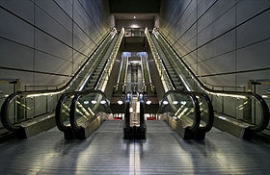- BY Admin
- POSTED IN Articles, Fără categorie
- WITH 0 COMMENTS
- PERMALINK
- STANDARD POST TYPE

An escalator is a moving staircase conveyor transport device for carrying people between floors of a building. The device consists of a motor-driven chain of individual, linked steps that move up or down on tracks, allowing the step treads to remain horizontal.
STORE OF INVENTIONS & TECHNOLOGIES FOR SALE : https://worldwideinvention.com/store/
Escalators are used around the world to move pedestrian traffic in places where elevators would be impractical. Principal areas of usage include department stores, shopping malls, airports, transit systems, convention centers, hotels, and public buildings.
The benefits of escalators are many. They have the capacity to move large numbers of people, and they can be placed in the same physical space as one might install a staircase. They have no waiting interval (except during very heavy traffic), they can be used to guide people toward main exits or special exhibits, and they may be weatherproofed for outdoor use.
In 2004, it was estimated that the United States had 30,000 escalators, and that people used escalators 90 billion times each year.
Escalators, like moving walkways, are powered by constant-speed alternating current motors and move at approximately 1–2 feet (0.30–0.61 m) per second. The maximum angle of inclination of an escalator to the horizontal floor level is 30 degrees with a standard rise up to about 60 feet (18 m). Modern escalators have single piece aluminum or steel steps that move on a system of tracks in a continuous loop.
“Crisscross” layout
“Multiple parallel” layout
“Parallel” layout
Escalators have three typical configuration options: parallel (up and down escalators “side by side or separated by a distance”, seen often in multilevel motion picture theatres), crisscross (minimizes structural space requirements by “stacking” escalators that go in one direction, frequently used in department stores or shopping centers), and multiple parallel (two or more escalators together that travel in one direction next to one or two escalators in the same bank that travel in the other direction).
Escalators are required to have moving handrails that keep pace with the movement of the steps. The direction of movement (up or down) can be permanently the same, or be controlled by personnel according to the time of day, or automatically be controlled by whoever arrives first, whether at the bottom or at the top (the system is programmed so that the direction is not reversed while a passenger is on the escalator).
Design and layout considerations
“Up” escalators in France next to a staircase
A number of factors affect escalator design, including physical requirements, location, traffic patterns, safety considerations, and aesthetic preferences. Foremost, physical factors like the vertical and horizontal distance to be spanned must be considered. These factors will determine the pitch of the escalator and its actual length. The ability of the building infrastructure to support the heavy components is also a critical physical concern. Location is important because escalators should be situated where they can be easily seen by the general public. In department stores, customers should be able to view the merchandise easily. Furthermore, up and down escalator traffic should be physically separated and should not lead into confined spaces.
Traffic patterns must also be anticipated in escalator design. In some buildings, the objective is simply to move people from one floor to another, but in others there may be a more specific requirement, such as funneling visitors towards a main exit or exhibit. The number of passengers is important because escalators are designed to carry a certain maximum number of people. For example, a single-width escalator traveling at about 1.5 feet (0.46 m) per second can move an estimated 170 persons per five minute period. The carrying capacity of an escalator system must match the expected peak traffic demand, presuming that passengers ride single file. This is crucial for applications in which there are sudden increases in the number of riders. For example, escalators at stations must be designed to cater for the peak traffic flow discharged from a train, without causing excessive bunching at the escalator entrance.
In this regard, escalators help in controlling traffic flow of people. For example, an escalator to an exit effectively discourages most people from using it as an entrance, and may reduce security concerns. Similarly, escalators often are used as the exit of airport security checkpoints. Such an egress point would generally be staffed to prevent its use as an entrance, as well.
It is preferred that staircases be located adjacent to the escalator if the escalator is the primary means of transport between floors. It may also be necessary to provide an elevator lift adjacent to an escalator for wheelchairs and disabled persons. Finally, consideration should be given to the aesthetics of the escalator. The architects and designers can choose from a wide range of styles and colors for the handrails and balustrades.




